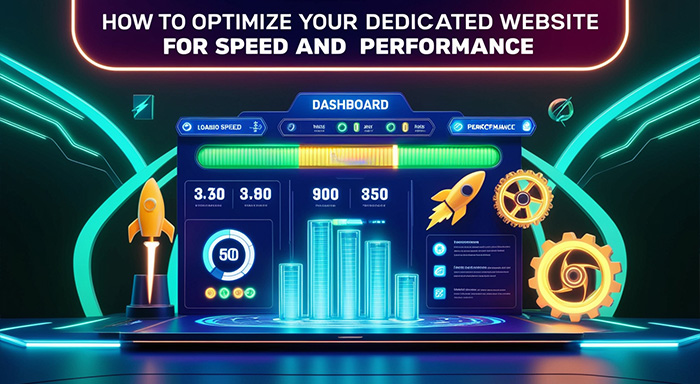Website performance includes measurable parameters and the users' perception of the effectiveness of a website experience that is focused more on the website's being quick and efficient. Entrepreneurs, web developers, and owners of websites can take great measures so as to enhance website performance, in which they can change multiple design elements such as coding structure, image sizing, third-party scripts, and so on. Among other measures, premium quality managed dedicated hosting services may be able to significantly enhance speed and performance, besides adding features of content caching and load balancing.
Thus, customer satisfaction will improve along with higher search engine rankings, increased online presence, and higher conversion rates due to faster page load times and more reliable websites. For instance, for websites that require more processing, like those that use a GPU server for deep learning, improvement techniques in website performance and speed are crucial for effective and blistering functionality.
Best practices for measuring website performance
One of the most important starting points for enhancing your website’s performance is to evaluate its existing performance. And by evaluating these crucial elements you’ll know which measures will lead to the most notable improvements.
You can make use of numerous performance-measuring tools such as Google Lighthouse, and Core Web Vitals. It is always best to start with Core Web Vitals, which are a group of 3 metrics that calculate essential key performance indicators of a website:
- LCP, i.e. Largest Contentful Paint - Evaluates the load time of the largest element on a web page.
- FID, i.e., First Input Delay - Evaluates the speed at which a web page processes user requests.
- CLS, i.e. Cumulative Layout Shift - Evaluates the uniformity of a web page’s visual elements.
Besides offering better core vitals you can elevate user experience, and also increase the ranking on search engine result pages. Other key performance metrics that need to be determined include Time to First Byte, DNS lookup speed, and Time to Interactive, i.e., TTI.
Steps to Optimize Website Performance
As there’s no one-size-fits-all solution for exceptional website performance, owners of the website can implement these proven techniques to improve speed as well as performance:
- Reduce Image Sizes
Images are large in size, so it can take a longer time to load on the website. An image file is generally much larger as compared to an HTML or CSS file. Fortunately, the time it takes for images to load can be shortened simply by optimizing the image, i.e., reducing its size, which generally involves downsizing the resolution and dimensions and compressing the actual image file itself.
- Restrict HTTP Requests
The majority of web pages need a browser to make several HTTP requests in order to download all sorts of assets on a given web page, like images, scripts, CSS files, and so on. In fact, numerous such elements are often required for web pages.
Each HTTP request is like a round trip, that is, to and from the server that hosts the website. That can add up when it comes to the load time for that web page. For these reasons, the number of assets that each webpage requires to load should be as small as possible. A speed test will point you in the right direction about which HTTP requests are taking the most time.
- Enable Browser-Level HTTP Caching
A web browser cache is a temporary location in browsers that stores copies of static files so that web pages that are recently visited will be able to load more quickly. Web developers can tell a browser to cache elements of a webpage that rarely change. Browser caching instructions should be present in the headers of HTTP responses from the web hosting server. This significantly minimizes the data transferred from the server to the browser, thus, resulting in accelerated page load times for visitors.
- Eliminate Unwanted Javascript That Blocks Rendering
Website owners need to recognize unwanted code that loads before the main web page content which can slow down your website’s loading time. This is often seen in large websites where different owners independently add code and content to them. Website owners should make use of web performance tools in order to find unnecessary code on web pages with poor performance.
- Limit the Excessive Use of Third-Party Scripts
If your website has a scripted webpage element that loads from a third party or outside commenting system, a CTA button, CMS plugin, or lead generation forms, must be loaded whenever a web page is requested.
Based on the script’s size, it can affect the web page loading speed and can potentially result in delays in loading or prevent the webpage from displaying at the same time. It is known as ‘content jumping’ or ‘layout shifting.’ It could be greatly annoying for smartphone users who are often required to scroll to view the complete page.
- Restrict the Number Of Redirections
A redirect takes place when website visitors to one web page are forwarded to another. Redirects can add small delays of fractions of a second, or sometimes a complete second, to the overall page load time. It's impossible to completely avoid redirects, but can often be overutilized. Therefore, website owners should set clear guidelines on usage and regularly scan key web pages for unwanted redirects.
- Minimize CSS and Javascript Files
Minimizing code refers to the removal of any unwanted code that a computer might not understand or execute, like comments, whitespace, and unwanted semicolons inside the code. It helps in reducing the file size of the CSS and JavaScript files, thus, loading a website a little bit faster within the browser and taking up a little less bandwidth. While JavaScript and CSS file minification generally provide minimal performance enhancements, it still remains a valuable best practice.
Conclusion
It can be a big challenge in terms of improving the performance of your website, however, it’ll indeed have a positive impact on your business when it would be one of your channels to reach your customers.
Also, even though this process doesn’t have a very well-defined beginning and end, you’re under no obligation to implement all of these changes today. Spend some time analyzing the performance-improving tool results, make some website changes, and then compare the before and after performance.
Do you need help with improving your website’s performance? You should certainly contact MilesWeb today who will ensure end-to-end visibility into all the parts of your application.
Related Posts:
Best Practices for Designing SaaS Websites
What is DNS Propagation and Its Impact on Website Performance?



